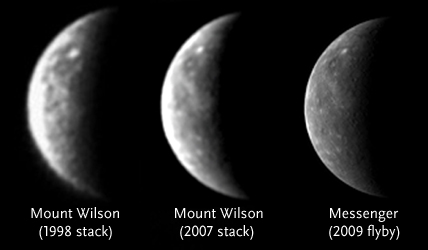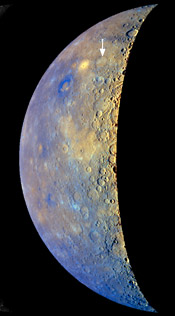Thanks to the wonders of digital photography and cheap memory cards, you probably lost count of how many pictures you took on your last vacation. Am I right? Heck, these days it's not unusual to delete a third or even half of all the snaps you take to find the "keepers."
But how about going through nearly 40,000 images just to find the 40 best ones? That's what Ron Dantowitz did after an observing run 12 years ago. Teaming up with Scott Teare and Marek Kozubal, he'd gotten some time on Mount Wilson's 60-inch reflector to image Mercury during a particularly favorable elongation on August 27, 1998. The hope was that Mount Wilson's legendary steady seeing would let them acquire diffraction-limited images of the elusive planet. Using off-the-shelf video equipment, they captured the planet when it was 27° up — 40 minutes after sunrise — using a near-infrared filter to increase contrast and the dome to keep sunlight off the telescope.

At left is a composite of 40 near-infrared images of Mercury taken in 1998 with a video camera attached to the 60-inch telescope on Mount Wilson (and, at center, as reprocessed in 2007). Compare them to the nearly identical — but much more detailed — view acquired last year by the Messenger spacecraft. Among the many features in common is the very bright spot above center. Click on the image for a larger view.
R. Dantowitz / S. Teare / M. Kozubal
Even in the raw video, Mercury's 37%-lit crescent looked impressive. But the hard work was only beginning.
Today amateurs routinely employ stacking — selecting and then combining the very sharpest images to yield the best possible detail. Programs like Registax do this almost automatically. But Dantowitz first had to digitize the analog video and then painstakingly find the best frames by hand. "Stacking" as we know it today hadn't been invented yet. The team called its technique "selective image reconstruction."
Fortunately, all that effort paid off. The resulting composite view showed never-before-seen details on a side of Mercury that had been totally missed during Mariner 10's flybys in the mid-1970s. Particularly intriguing was a very bright 100-mile-wide spot, located at 35°N, 300°W, that the team imagined to be some kind of impact feature. The three amateurs published a tidy article in the Astronomical Journal's May 2000 issue, and that should have been the end of the story.
But as the years went by, Dantowitz kept wondering about the nature of that bright feature. In 2008, knowing that NASA's Messenger spacecraft would soon reveal the true nature of his find — and the entire planet, for that matter — he petitioned the International Astronomical Union to have the bright spot named for American composer Aaron Copland. (The IAU names craters on Mercury after artists, musicians, painters, and authors.)
"Copland wrote Fanfare for the Common Man, one of the most recognizable pieces of 20th-century American classical works," Dantowitz noted in his petition. "This Mercury feature was discovered by using common, off-the-shelf commercial video equipment installed by an elementary-school science teacher doing research at a professional observatory. A true discovery that is a 'Fanfare for the Common Man'!"

The Messenger spacecraft captured this false-color view of Mercury during its third flyby of the planet on September 29, 2009. The bright spot seen from Earth doesn't look like other craters, and its origin remains unclear. The IAU has assigned the name Copland to the large basin just to the spot's east (arrowed). Click on the image for a larger view.
NASA / JHU-APL / Carnegie Inst. of Washington
Last year Messenger did reveal an intriguing bright spot exactly where the Mount Wilson team had spotted it more than a decade earlier. But it's very strange — probably volcanic in origin — so the IAU's planetary moniker-makers and Dantowitz agreed to assign Copland to a true impact basin, 129 miles (208 km) across, adjacent to the mysterious white spot. The naming was announced last week on the Messenger website.
"I finally feel happy about the Mercury work!" Dantowitz exults. Revealing an unseen side of the planet, armed with $100 videocams and sheer determination, was a real triumph. "If only I had then the cameras and computers that I have now," he muses.
(Full disclosure: Dantowitz is now director of Clay Center Observatory, located at the Dexter and Southfield Schools in Brookline, Massachusetts. I teach there part time, and Dantowitz is my boss. No matter, though: he's absolutely fanatical when it comes to coaxing telescopes and instruments to perform at their very best — and then some!)
 5
5
Comments
[email protected]
March 23, 2010 at 7:03 am
the article gives the coordinates of "Copeland" as 35°;N, 300°W ...shouldn't it be 60 deg East ?
if i'm in error please let me know...gently 😉
You must be logged in to post a comment.
Kelly Beatty
March 23, 2010 at 7:57 am
A great question, actually. By IAU convention, longitudes increase westward on prograde planets (e.g. Mercury, Mars) and eastward on retrograde planets (e.g. Venus). Only the Moon and Earth have both east and west. Geophysicists have generally adopted an "all east" approach on other planets, which is at odds with the IAU convention, so you'll sometimes see both systems used.
You must be logged in to post a comment.
Bob Kieckhefer
March 27, 2010 at 10:11 am
You mention stacking, including the comment "Stacking, as we know it today hadn't been invented yet" [in 1998]. This may be true in astronomy, but we geophysicists have been "stacking" seismic-reflection data since the mid 1960s, when exploration geophysics went digital. The basic idea in both geophysics and astronomy is to align images and sum them. The signal should add by n (the number of images being stacked), and the random noise should only increase by the square root of n; hence the signal-to-noise ratio increases by the square root of n.
In geophysics, we group together seismic-reflection data that reflected from the same subsurface point, and stack (sum) them. In the early days, we assumed that these subsurface points were the midpoints between shots (explosions) and receivers (geophones). Four decades later, we are a lot more clever about how to determine the reflection points before stacking.
A significant difference in the two fields, pointed out by Kelly Beatty, is that in geophysics, we use most of the data, and only delete obviously noisy data. In astronomy, especially in this Mercury case, most of the raw data were discarded, and only the best images were kept and stacked.
You must be logged in to post a comment.
Harro Treur
March 28, 2010 at 1:23 pm
Utterly amazing: several craters are recognizable in the 2007 picture.
This must be the first time craters on mercury have been photographed. Ã wonderful achievement!
This also gives some extra body to the historic claim of John Mellish's visual observations some 100 years ago.
You must be logged in to post a comment.
Wilfried
March 29, 2010 at 2:27 am
Did any of the various space telescope ever take comparable images of mercury? Apparently, the Hubble space telescope did not. Is Mercury too close to the sun for Hubble?
You must be logged in to post a comment.
You must be logged in to post a comment.